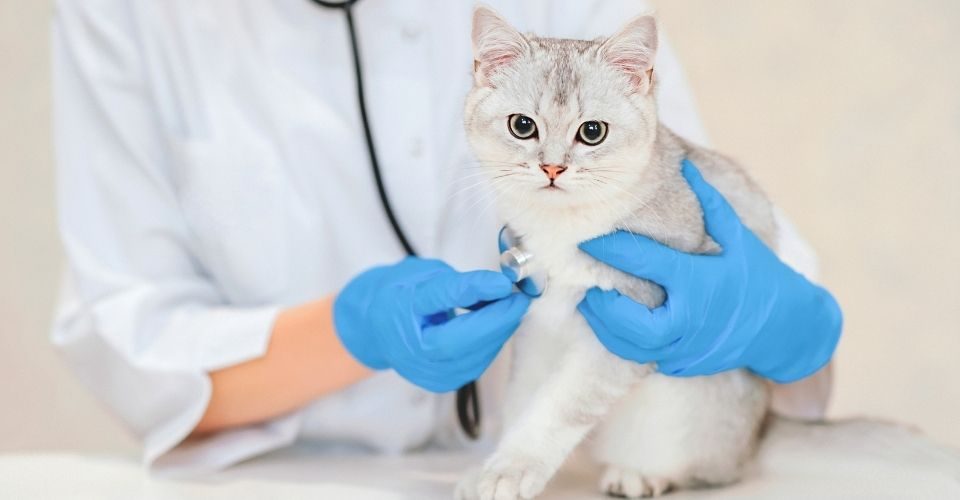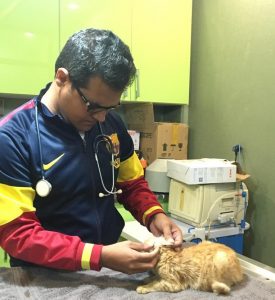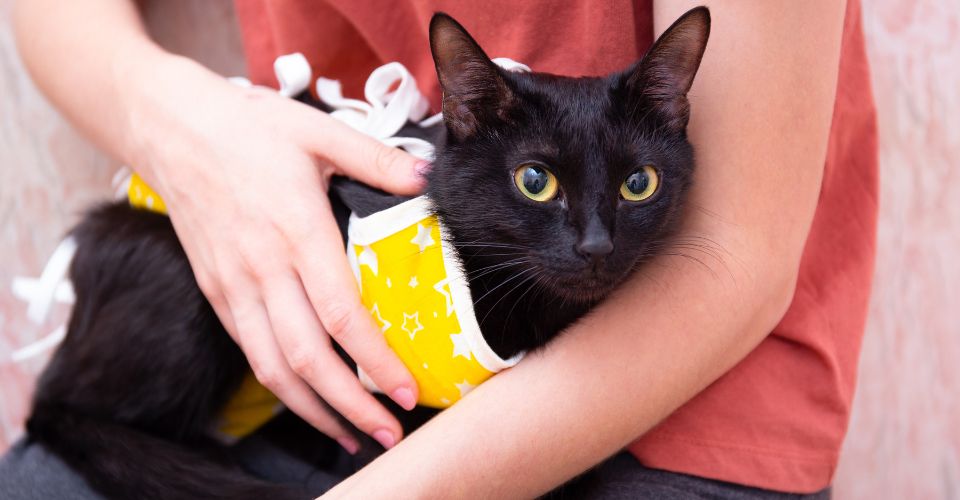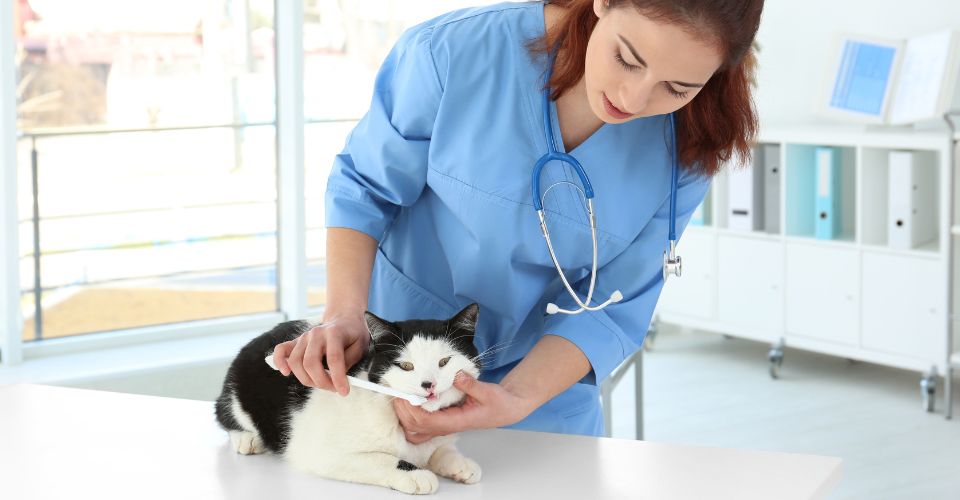Feline infectious enteritis (FIE), commonly known as cat or feline distemper, is a contagious and deadly viral disease in cats. Distemper in cats is caused by the feline panleukopenia virus (FPV).
The virus attacks the rapidly dividing blood cells in the cat body–skin, intestinal tract, and bone marrow–weakening the defensive mechanism. This makes infected cats more susceptible to other deadly feline diseases. There is no proper cure for this life-threatening viral disease. But worry not! Distemper in cats can easily be prevented by vaccination.
Feline Panleukopenia Virus
Feline panleukopenia virus (FPV) belongs to the parvovirus family. If you have puppies, you might be familiar with the term parvovirus virus infection, as it is a big concern among the dog population, especially the young puppies. The FPV is quite similar to the canine panleukopenia virus. But the FPV is way more lethal than its counterpart and is also comparatively difficult to remove from the environment.
FPV consists of a single strand of DNA, having a protein coating. It is described as a ubiquitous virus as it is extremely stable, withstanding even harsh environments. Indoors, it can survive for up to a year. It can even survive freezing temperatures.
Distemper in Cats
The feline distemper virus is found across the world and infects both domestic and feral cats. In addition to cats, it also infects raccoons, foxes, and minks, etc. If your cat is vaccinated against the vicious feline distemper virus, you need not worry–it is only endemic in unvaccinated cats.
Distemper in Kittens
While both adult cats and baby kittens are affected by the feline distemper virus, kittens are most vulnerable to it due to their fragile immune system. As kittens start feeding on their mother’s milk, they develop a passive immunity against the FPV. The mother milk provides them the antigens necessary to ward off the virus from infecting the kittens. These maternally acquired antibodies will start to decline after 6 to 8 weeks as the kitten is totally weaned off the mother’s milk. At this stage, if she has not received her distemper shot for kittens, she will be susceptible to the virus.
How is the Virus Transmitted?
Not only life-threatening, but feline distemper is also contagious. The FPV is present in everything excreted or secreted by infected cats. For instance, it is present in their feces, urine, saliva, and vomits. As a cat comes in contact with the contaminated fluids, the virus enters her body by the oral-fecal route.
The virus can also be transmitted to the cats through their owners’ hands, who have not washed their hands properly after handling multiple cats.
If the cat has been inoculated with the feline distemper vaccine, the viruses will not do any harm to your cat. Otherwise, it will lead to the development of oral infection, and then the disease will develop as the virus starts replicating in the mitotically active cells such as lymph nodes, bone marrow, spleen, thymus, and the intestinal tract.
As a result, the leucocytes, commonly known as white blood cells, may rapidly decrease–often by 90 percent–resulting in panleukopenia. These white blood cells are responsible for defending the body against infections. Consequently, cats with panleukopenia also become more prone to many other deadly infectious diseases.
Feline Distemper Symptoms
Cats are stoic creatures. Meaning that they do not let others get an idea about their sickness or weaknesses. This is the reason that many cat owners, even the responsible ones, often fail to realize that their cat has been sick for a while. Therefore, you must never miss a regular vet checkup. In addition to that, you must familiarize yourself with signs your cat is sick.
To be able to tell if your cat has caught the feline distemper virus or not, you need to look for the following signs of sickness in your cats, according to PetMD.
- Anemia
- Diarrhea
- Dehydration
- Weight Loss
- Anorexia
- Depression
- Excessive Hiding
- Lack of Coordination
- High Fever
- Rough Hair Coat
Diagnosis of Distemper in Cats
If you even have a suspicion that your cat might have caught the distemper virus, you should get extra observant of her behavior. If your cat is exhibiting even two or three of the above-mentioned signs, you should ring your vet. Make an appointment for a thorough examination of your cat, especially if your cat has come in contact with some other cats or has been outside for a while.
You should take your cat to your personal vet. This is to ensure that the vet has a complete history of your cat’s health. You should also tell your vet about the recent activities of your cat. According to PetMD, distemper in cats can mimic other feline diseases such as feline immunodeficiency virus (FIV), feline leukemia virus (FeLV), poisoning, and pancreatitis, etc. Therefore, you must provide your vet all the details.
The vet will physically examine your cat from her whiskers to the tail, in addition to routine laboratory tests, including urine, fecal, and blood tests. If distemper has been affecting your cat for a long time, she might have developed many other diseases, too, due to her declining immune system. This makes it difficult for a vet to diagnose distemper in cats.
However, as the FPV attacks and destroys the diminishing cells in the bone marrow and other mitotically active regions, the extremely low number of blood cells will tip the vet that your cat might have panleukopenia.
Can Feline Distemper be Treated?
Unfortunately, like most viral infections, there is no proper treatment for feline panleukopenia or feline distemper. The antibiotics only keep secondary bacterial infections from developing, which are likely due to the weakening of immunity with the declining number of white blood cells.
However, if you could get your cat to the vet at the early stage, immediate treatment, including intravenous fluid therapy and intensive care, might help save your fluff ball.
If you are lucky, with the aggressive supportive care, your cat will fully recover from the illness. But it does not end here; once your cat is back home, you will have to be extra careful about her hygiene. If you have other animals, you will have to isolate your cat until all of the symptoms discussed above have resolved. Before ending the quarantine, you should first get a green light from your vet.
We guess it is crucial that you know the mortality rate for cats with panleukopenia is as high as 90 percent. Therefore, you should prepare yourself for the sad news.
How to Prevent Distemper in Cats?
There is no real treatment for distemper in cats; prevention is the only way forward. You can prevent your cat from catching an infection by getting her vaccinated for distemper and by making sure that everything accessible to her is disinfected.
Feline Distemper Vaccination
All cats and kittens must receive the feline distemper vaccination. The feline distemper vaccination is highly effective. This is the reason that distemper is only endemic in unvaccinated cats. Therefore, if you have adopted a cat or have rescued one, you should first take her to the vet for the examination to confirm if she has received her distemper shots. If not, get her vaccinated at the earliest.
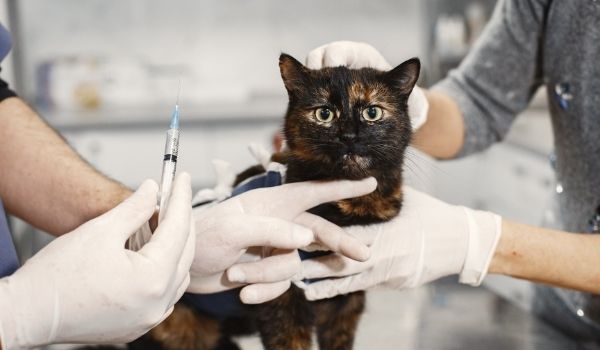
When to Vaccinate Kittens
As discussed above, kittens have maternally acquired antigens so they have immunity against FPV. But as they wean off, they must receive their kitten distemper shots. During this immunity gap, the antigens are too low to fight the notorious FPV on their own but are high enough to intervene with vaccination. Therefore, your kitten must receive her first distemper shots at the age of 6 weeks. These distemper shots should be given to the kitty every 3 to 4 weeks until she is 4 to 5 months old. After a year, there should be revaccination; after that, she should receive her shots every three years.
Disinfecting Feline Distemper Virus
Many cat owners use alcohol-based disinfectants for removing the notorious FPV from their homes, but unfortunately, alcohol-based sanitizers do not work against the FPV. Feline lovers are advised to use bleach and other products in the bleach family such as calcium hypochlorite to effectively inactivate FPV.
Using Bleach for Disinfecting Distemper Virus
Undoubtedly, bleach is the most effective disinfectant against viruses, including the FPV or feline distemper virus. However, you need to be careful while using bleach. You should use it only in diluted form as concentrated bleach could be corrosive and irritating to both humans and their pets, especially young kittens.
To begin with, disinfecting with bleach is a two-step process—before applying bleach, you have to clean the place first. Bleach dilution is very tricky. A too weak solution will be ineffective against the notorious FPV, and a too strong solution would be harmful to you as well as your four-legged friend. According to Shelter Medicine Programs at the University of Wisconsin and UC Davis, “5% household bleach should be freshly diluted at 1:32 (1/2 cup per gallon).” You should also note that bleach is inactivated by light, so you should keep it in a light-proof container. When diluted, it will remain stable for only thirty days, and in an undiluted form, it will be stable for around 200 days.
Now that you know how deadly and contagious distemper in cats can be, you should make sure that your feline friends receive their vaccination shots on time.

